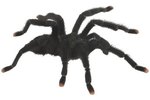
Many lizard species have evolved great speed and have common names, like racerunner or racehorse goanna, that reflect this. While accurate data isn't available for most species, some lizards have been tested in controlled settings. Species that rely on speed for survival usually have specialized adaptations to help them catch food and avoid predators. Even in those species that aren't fast, body temperature influences their speed, and they move quickest when temperatures are high.
Basilisks
Basilisks are native to tropical Central and South America and are well known for their ability to run across the surface of water. These lizards are quite fast, using locomotion as a primary defense tactic. Basilisks can run so fast that their front legs often come off the ground when sprinting. Despite this, laboratory tests have shown that green basilisks are not as fast as is commonly thought, only attaining top speeds of 7 mph. Incredibly high speeds are likely not necessary for these lizards as they inhabit dense, forested habitats rather than the wide-open spaces usually associated with fast animals.
Racerunners
The six-lined racerunner (Cnemidophorus sexlineatus), which has been clocked at 18 miles per hour, is native to the southern United States. Utilizing open habitats, these lizards must be quick enough to avoid quick predators like black racers (Coluber constrictor) and red-shouldered hawks (Buteo lineatus). These lizards thrive at high temperatures that allow them to maximize their running speed. Indeed, racerunners are often active during the hottest part of the day, unlike most lizard species that retreat underground when mid-day temperatures climb.
Spiny-Tailed Iguana
The spiny-tailed iguana (Ctenosaurus similis) is listed as the fastest recorded lizard in many older sources. Known to reach a speed of 21 miles per hour, these iguanas are omnivorous lizards native to Central America. When tested thoroughly in a laboratory setting, researchers were able to show that the adults could attain higher speeds and maintain high speeds longer than juveniles could.
Large Monitor Lizards
A few large species of monitor lizard (Varanus sp.) are known to be very fast. Many Australian monitor lizards have great speed as an adaptation to their wide-open homeland; in fact, some monitors are colloquially termed "racehorse goannas" in Australia. The perentie monitor (Varanus giganteous) is the fastest of the monitors -- and also the fastest lizard ever recorded. The perentie has been clocked at about 25 mph -- the running speed of a world-class sprinter. Perentie monitors must be fast to catch their quick prey: namely rabbits and other monitor lizards.
References
- University of California, Riverside: Physiological Correlates of Locomotory Performance in a Lizard: An Allometric Approach
- Savannah River Ecology Laboratory: Six-lined Racerunner (Cnemidophorus sexlineatus)
- San Diego Zoo: Reptiles: Lizard
- American Museum of Natural History: Green Basilisk
- National Council on Strength & Fitness: The Limits of Human Speed
- Copeia: Running Speed of the Lizard Basiliscus basiliscus on Water
- Academicjournals.org: The Influence of Body Temperature on Sprint Speed and Anti-predatory Defensive Responses of the North African Monitor Lizard, Varanus griseus
- Arkive.org: Perentie (Varanus giganteus)
Photo Credits
-
Photodisc/Digital Vision/Getty Images




